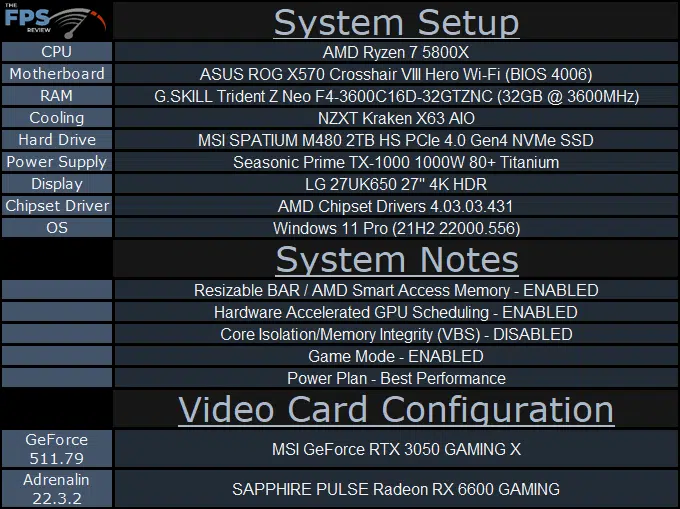
Introduction
MSRP has meaning, purpose, and value, and we don’t want to see the MSRP value disappear. The fact is that today, the street pricing versus MSRP is wide and far apart, and that’s just the fact as it exists today. Such is the case with the GeForce RTX 3050 video card versus Radeon RX 6600 video card.
The GeForce RTX 3050 was launched in January of 2022 with an MSRP of $249. However, the street pricing you will end up paying for the card has been much higher. According to PCPartPicker GeForce RTX 3050’s range from the low-end pricing of $349 up to $499 with the average pricing being around the $400 mark right now. With prices at these levels, the GeForce RTX 3050 has pushed up into Radeon RX 6600 territory, not the Radeon RX 6500 XT with which it was meant to compete.
The AMD Radeon RX 6600 launched in October 2021 with an MSRP of $329. According to PCPartPicker Radeon RX 6600’s (not the XT) range from the low-end pricing of $369 up to $480 with an average around $400. The Radeon RX 6600 is a lot closer to its MSRP than the GeForce RTX 3050 is to its own MSRP. The Radeon RX 6600 exists within the price range that the GeForce RTX 3050 does in today’s street pricing, they overlap and average around the same pricing.
As you can see, the GeForce RTX 3050 is actually within the same price range as the Radeon RX 6600. This being the case we must compare the two video cards to each other in performance. There is potential for the Radeon RX 6600 to be the better value right now between the two. Therefore, in today’s performance comparison, we pit the GeForce RTX 3050 versus Radeon RX 6600 in several games and test DLSS, FSR, and Ray Tracing.
Video Card Specs
The GeForce RTX 3050 is based on NVIDIA’s Ampere architecture manufactured on SAMSUNG 8nm FFN. It has 2,560 CUDA Cores, 48 ROPs, 80 Texture Units, 20 2nd Gen RT Cores, and 80 3rd Gen Tensor Cores. The boost clock is set at 1777MHz. It has 8GB of GDDR6 memory at 14GHz on a 128-bit memory bus at 224GB/s of memory bandwidth. The TGP is rated at 130W.
The Radeon RX 6600 is based on AMD’s RDNA2 architecture manufactured on TSMC N7. It has 28 Compute Units, 28 Ray Accelerators, 1,792 Stream Processors, 64 ROPs, and 112 Texture Units. It has 32MB of Infinity Cache. The game clock is set at 2044MHz and the boost clock is set at 2491MHz. It has 8GB of GDDR6 memory at 14GHz on a 128-bit memory bus at 224GB/s of memory bandwidth. The TDP is rated at 132W.
| Specification | NVIDIA GeForce RTX 3050 | AMD Radeon RX 6600 |
|---|---|---|
| Fabrication Process | SAMSUNG 8nm FFN | TSMC N7 |
| Architecture | Ampere | RDNA2 |
| Infinity Cache | N/A | 32MB |
| CUDA Cores/Stream Processors | 2560 | 1792 |
| ROPs | 48 | 64 |
| Texture Units | 80 | 112 |
| RT Cores/Ray Accelerators | 20 (2nd Gen) | 28 |
| Tensor Cores | 80 (3rd Gen) | N/A |
| Game Clock/Boost Clock | 1777MHz | 2044/2491MHz |
| Memory | 8GB GDDR6 | 8GB GDDR6 |
| Memory Frequency | 14GHz | 14GHz |
| Memory Bus Width/Bandwidth | 128-bit / 224GB/s | 128-bit / 224GB/s |
| TGP/TDP | 130W | 132W |
| MSRP | $249 | $329 |
In terms of specifications, the two video cards have the same TDP and memory configuration. The same 8GB of GDDR6, on the same 128-bit bus, and have the same memory bandwidth of 224GB/s of bandwidth. Other than the architecture differences in the GPU, the TDP and memory is very similar between the two. The GeForce RTX 3050 supports NVIDIA DLSS and can run FSR. The Radeon RX 6600 runs FSR. Both video cards support Ray Tracing, but only the RTX 3050 has Tensor Cores, and only the 6600 has Infinity Cache.
Test Setup
For our review today we are going to compare two retail video cards. We are going to use the MSI GeForce RTX 3050 GAMING X video card which has a factory overclocked boost clock of 1845MHz. We are going to use the SAPPHIRE PULSE Radeon RX 6600 GAMING video card which runs at the AMD reference clock speeds.

